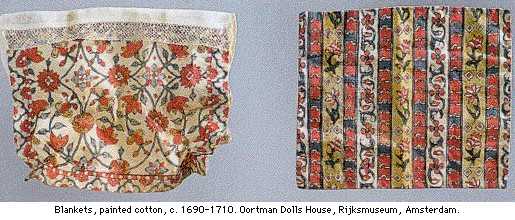

In the Thins/Vermeer household, comprised of three to four adults and eleven children in 1676, one would expect a rather large number of blankets. This is however not the case, as they are only mentioned in the inner kitchen, room C; and in the cooking kitchen, room D. How is this possible?
Bedsteads, which are indicated with a boxed-in X on the floor plan below, (Zantkuijl 2001), are always connected to the structural parts of the house. People slept, sitting up, propped up by pillows. Under the bedstead, which was always intended for two adults, were drawers on wheels, called "laden"(drawers) or "rolkoetsen" in which children could be put and then slid in. These were proverbially known in Dutch as as 'kids slid under', or "ondergeschoven kinderen" . Were their sleeping spaces poorly ventilated and quite claustrophobic, or were they snug, safe and warm? See bedsheets.

Note : This object was part of the Vermeer-inventory as listed by the clerk working for Delft notary public J. van Veen. He made this list on February 29, 1676, in the Thins/Vermeer home located on Oude Langendijk on the corner of Molenpoort. The painter Johannes Vermeer had died there at the end of December 1675. His widow Catherina and their eleven children still lived there with her mother Maria Thins.
The transcription of the 1676 inventory, now in the Delft archives, is based upon its first full publication by A.J.J.M. van Peer, "Drie collecties..." in Oud Holland 1957, pp. 98-103. My additions and explanations are added within square brackets [__]. Dutch terms have been checked against the world's largest language dictionary, the Dictionary of the Dutch Language (Woordenboek der Nederlandsche Taal , or WNT), which was begun by De Vries en Te Winkel in 1882. In 2001 many textile terms have been kindly explained by art historian Marieke de Winkel.
Illustration taken from the recently published handbook on Dutch Doll Houses by Jet Pijzel-Dommisse,Het Hollandse pronkpoppenhuis, Interieur en huishouden in de 17de en 18de eeuw, Waanders, Zwolle; Rijksmuseum, Amsterdam, 2000, ill. 167.
This page forms part of a large encyclopedic site on Vermeer and Delft. Research by Drs. Kees Kaldenbach (email). A full presentation is on view at johannesvermeer.info.
Launched December, 2002; Last update March 2, 2017.
Back to the Welcome page: click Welcome.